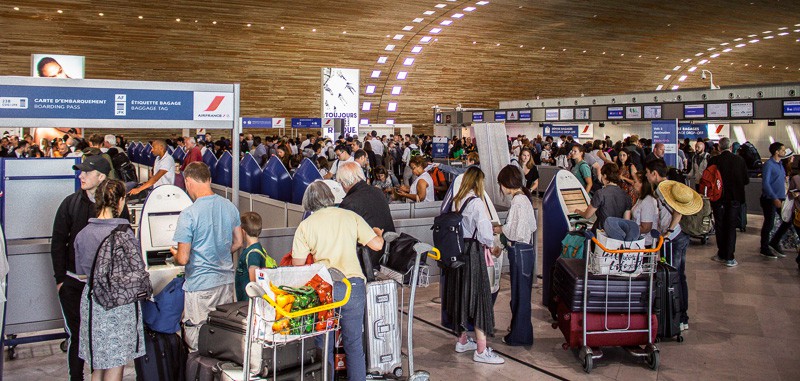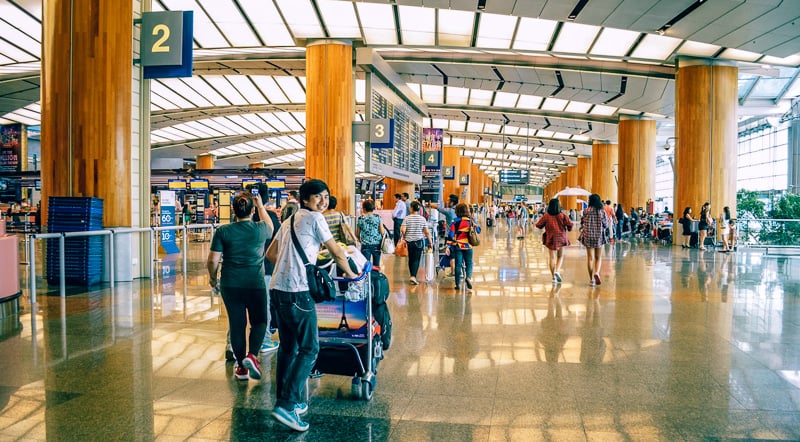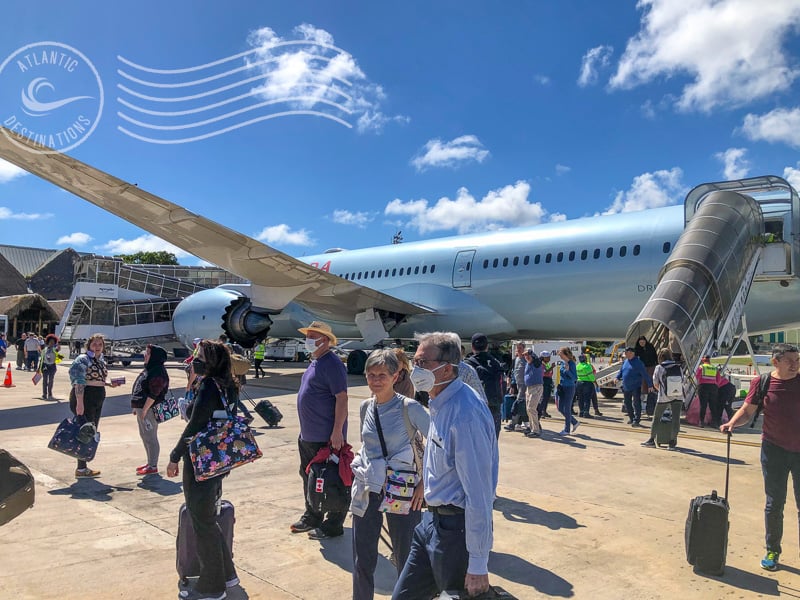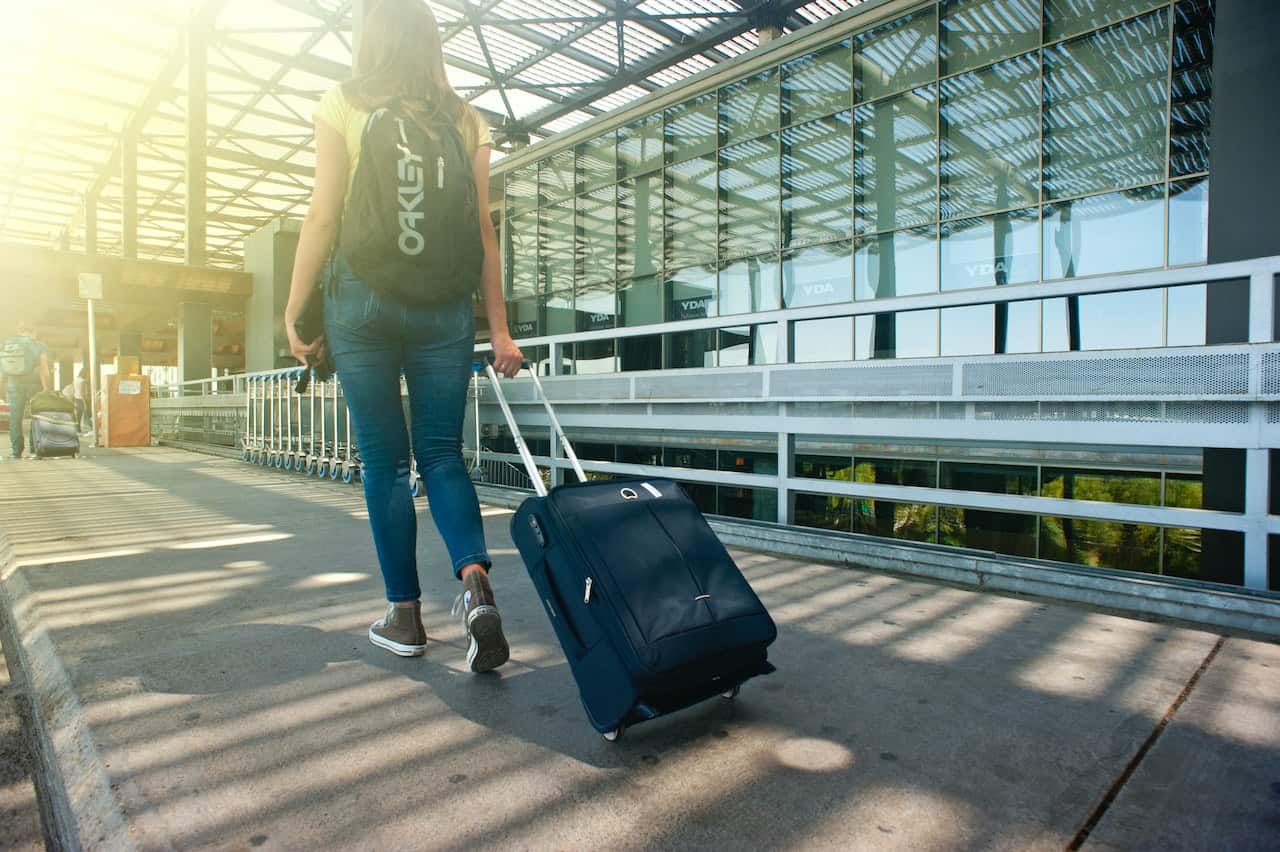10 best strategies to help with airport anxiety
Share:

Traveling by air and getting through an airport can be a daunting experience. From navigating the security lines to dealing with long waits and tight connections, there’s plenty of potential for airport anxiety.
But it doesn’t have to be that way!
With these few simple tips, you can make your next trip through an airport stress-free and secure. Here are 10 strategies to help with airport anxiety and keep yourself safe, reduce anxiety, and ensure smooth sailing on your next journey.
Please note that as an Amazon Associate I earn from qualifying purchases.
It’s an airport — what could possibly go wrong?

Well, lots…! A recent survey polled UK travellers to find out what worries them most before travelling and during their time in an airport. Some of these might seem familiar to you too:
- #5 – your flight being delayed
- #4 – misplacing your passport
- #3 – missing your flight
- #2 – losing your baggage
And the #1 thing that caused the most airport anxiety?
- Getting stuck in traffic on the way to the airport…!
The survey was published by Priority Pass, a company that operates more than 1300 airport lounges, mini-suites, and restaurants. Their results show that most of us are concerned about the same things, and all we need is a few strategies to reduce airport anxiety and make things, if not pleasant, then at least tolerable.
Actions you can take now to help with airport anxiety
Lets look at some things you can do to de-risk your travel and maybe even allow you to enjoy your airport experience.
#1 – Make your flight on time
There’s no airport anxiety greater than having to rush through the terminal, panicked, and thinking every step of the way: “OMG, I’m going to miss my flight!”
Reducing this worry starts WAY before the day of your journey. Here’s a few things you can do to remove the worry:
- When booking, choose an early morning flight. There’s less people at the airport and smaller lines at check-in and security. And flying schedules haven’t had time to back up yet meaning less delays. If you don’t fly out till 9:30 or 10 am, things can be very different!
- Avoid peak times such as weekends and holidays whenever possible. Flights and hotels tend to be more expensive during these times and there may also be larger crowds than usual at the airport.
- Leave home early. Even if there’s heavier traffic, you’ll have time to get through it and still make your flight.
- Leave your car at home and have a family member or friend drive you to the airport and pick you up when you get back. You’ll save lots of time and stress if you’re not having to park your car when you arrive, and then try to find it in the airport garage when you get back.
#2 – Protect your baggage

Yes, I’ve lost my checked bags a few times in my long travel career. But here’s what you can do to de-risk that concern:
- Put all your essentials in your carry-on bag(s). Medicines, basic toiletries, even a change of underwear and a t-shirt will carry you over until the airline finds and delivers your bags to you. And that usually doesn’t take too long — when airlines have lost my bags, they’ve always found and transported them to where I’m staying free of charge.
- Pack as light as you can. Pack only the items that you really need and leave everything else at home. Remember, you can always buy things you need at your destination. It’ll keep baggage costs down and, if you’re like me, it’ll save wear and tear on your arms lifting and dragging the bags around. Pack more in smaller bags by rolling your clothes instead of folding them, which also reduces wrinkles.
- Is it worth packing light enough to only need carry-on bags? It would certainly guarantee that your baggage won’t take a journey of its own and it will speed up international connection time when you don’t have to wait for your checked baggage before visiting the customs agent. But keep in mind the rather small size of bags accepted on board, and the baggage congestion that everyone’s on-board baggage creates. If you’re last on the plane, your bag might end up stowed far away from your seat. The older I get, the more I’m willing to risk checking heavy bags.
- Consider using a TSA lock to secure your baggage. These locks can be opened by security agents with a master key, which allows them to inspect your baggage without damaging it or a non-TSA lock. You can identify any TSA-approved lock by its red diamond logo and they’re recognized by other security agencies in Canada, Switzerland, Germany, Australia, New Zealand, Japan, China, and other countries (see this comprehensive list). Also available: suitcases with built-in TSA combination locks.
- You can still use your own non-TSA lock, but customs agents may cut open the lock or damage your bag to complete their inspection with no compensation for your broken property.
#3 – Easy ways to keep all your travel documents straight
The objective is to have your documents close-at-hand and ready when you need them. First, here’s a quick checklist of documents you may need:
- Passport
- Driving license (if applicable)
- Visa (if required for the country you’re visiting)
- Record of vaccinations (if required for the country you’re visiting)
- Boarding passes
- Flight details
- Airport parking ticket
- Lounge card (if applicable)
- Rental car documents (if you’re renting/ hiring a car in the country you’re visiting)
- Hotel reservations
- Itinerary
- Transfer information to your accommodation
- Pre-booked excursion details
- Travel insurance
- Emergency contact information
Now, how do you keep all these documents organized? Having them ready will certainly cut down on airport anxiety:
- Save or print documents as soon as you receive them. When booking your flight or making other travel arrangements, save or print the documents you get right away and save them all in one place. That way when you’re doing your final packing, you’ll have all your travel documents ready to go.
- When you can, save key documents on your smartphone. If you use a smartphone, you can usually save your boarding passes in an easy-to-access “wallet” on the phone. At the airport gate, you can scan these directly from your phone by laying it on the scanner. Also, use airline apps to have instant access to such things as your itinerary, travel points ID, and flight numbers. No paper means no muss-no fuss and easy access.
- Keep paper documents in one place. Keep all documents that can’t be scanned, such as passports, visas, hotel arrangements, in a single place in your carry-on. First, it’s easier to protect them if you only have to be mindful of on place. Second, when you finish using one of those documents (for example at check-in), put it away in that same place and get the documents for the next station (such as security) ready to go. You’ll be ready every time you need to show something, and your documents will be centralized in case you need to find a particular one quickly.
#4 – Best ways to get through security successfully
The airport security experience can be stressful for most people, especially if you’re not familiar with the process. While it’s unlikely that you’ll eliminate ALL the airport anxiety of this experience, there are things you can do to help make the whole ordeal less overwhelming and more manageable.
Preparation before you leave home:
- All liquid and gel items must be in 100 millilitre (3.4 ounces) or smaller containers. Put larger containers in your checked baggage (but make sure they’re tightly sealed) or buy new ones at your destination. Put every liquid and gel product in your carry-on into a single, one-quart zip-closure clear plastic bag. Food items like peanut butter and jello are considered gels and will be confiscated as the containers are typically more than 100 ml.
- Prescription liquid medications can be brought through security. Prosthetics and medical items are also permitted. But everything must be screened so tell the agents about the items you have and ask them to screen the items visually if X-rays will harm them.
- Important: Always keep your prescription medications in your carry-on bags. Don’t trust that your checked baggage will arrive by the time you need your next dose. You can also mail them ahead but in some countries, that can also be a bit of a gamble.
- Wear as little metal as possible.
- Wear shoes that can be easily removed. Also wear socks so you’re not padding around barefoot on the security floor (just remember how many thousands of people walk on that floor every day!)
- Top tip: make sure all your electronic devices are fully charged before you travel. In some jurisdictions, you need to be able to turn on the devices to show they work to take them through security.
When you arrive at the airport

- Go through the security line as soon as you can to avoid a security delay jeopardizing getting to your gate on time for boarding.
- Remember that duty-free shop purchases are also subject to the same security rules as other liquids. If you try to take your purchase through security (this can happen if you have a connecting flight) it may be confiscated. Alternatively, if you can get to your checked baggage (and you have the time) you can stow it there before going through security.
Going through a security check
- Have your ID (passports work really well) and/or boarding pass ready – you’ll need to show them when you first arrive at the security line.
- Procedures can be slightly different at different airports. Read the signs and listen to the security agents who often call out what you need to know. But If you’re in doubt, ask as you arrive at the security area. I’ve usually found agents to be courteous and helpful.
- At the conveyer belt, unpack these items and put them in the plastic tubs: your computer (out of it’s bag), the contents of your pockets, your shoes and belts if you’re required to take them off, and your jacket or coat. I usually put my wallet and my phone in my carry-on case at the last minute and put it on the conveyer. All these go through the security x-ray machine.
- The next step may involve the large body-scanning device. Just follow the directions of the agents. If there’s something in the x-ray of your carry-on bags that they’re not sure of, you may need to review the contents with them. Be honest and accommodating and things will typically go smoothly.
- Quick tip: Because you can’t take liquids through security, even bottled drinks or food you’ve brought with you might be confiscated. There’s two options: go back to the beginning of the security line and eat or drink it all before going through security (no, thank you) or just wait until you’re through security to buy what you want at an airport shop in the secure part of the airport (preferable).
After completing the security check
- Take a breath — you made it! Also, take a moment to review that you have everything so you don’t inadvertently leave something important at the security station.
Knowing what to expect, will take the worry out of the security screening. Just remember that the security team is there to keep us safe during flight. Follow these tips and soon you’ll be breezing through security with ease!
#5 – Trusted traveller programs

Waiting in long lines at the airport is miserable. But if you fly regularly, there are programs that will save you time and help with airport anxiety. Here are a few of them:
- TSA PreCheck: a US program that allows low-risk passengers departing from the United States to receive expedited screening with smarter security and a better air travel experience. Apply online $85 application fee – good for five years. You’ll also need to schedule an appointment at one of the 380-plus enrolment centres to get fingerprinted and go through a background check.
- Global Entry: for international travellers, Global Entry provides expedited U.S. customs screening when entering the United States. Global Entry members also receive TSA PreCheck® benefits as part of their membership. $100 application fee – good for five years.
- Mobile Passport Control (MPC): US Citizens and permanent residents can submit their passport and customs declaration information through this free, secure app and reduce the time they spend going through passport control inspection.
If you’re traveling to or from Canada:
- ArriveCan: when you enter Canada, submit your customs declaration through the advanced Canada Border Services Agency (CBSA) declaration feature in ArriveCAN to save time at the border.
For US/ Canadian citizens and permanent residents and Mexican nationals who are members of the Viajero Confiable program:
- NEXUS: as a pre-screened traveler, you’ll get expedited entry to the US and Canada either by air or by sea using dedicated processing lanes. NEXUS is a joint CBSA and U.S. Customs and Border Protection trusted traveler program for pre-approved, low-risk travellers.
#6 – How not to lose your car in the parking lot
As we’ve mentioned above, the easiest and least stressful way to get to and from the airport is having a family member or friend take you there and pick you up — it saves time and there’s no parking hassles.
But if that’s not possible, you can use these tips to make losing your car a thing of the past:
- When you first park, use your smartphone to take a photo of the parking lot location marker. When you get back, you have an instant reminder of where you are.
- If you don’t own a smartphone with a camera, park near a landmark that’ll be easier to remember than “Yellow-P5” or “Orange-C15”.
- If there’s a free spot, park at the end of a row. Your car will be much easier to spot on your return.
#7 – Money
By itself, the thought of theft is enough to give you airport anxiety. But here’s a few things you can do to help keep your money and valuables safe:
- Keep your valuables in your hand luggage – If your valuables are always with you in the airport or on the plane, it’ll be easier to protect them. I try to keep mine in the bag that I put under the airplane seat in front of me. There’s also your carry-on that goes in the overhead bins if you have more than will fit under the seat.
- Credit cards – Call the credit card company in advance to make sure your card can be used in the country you’re going to. Some may have special travel cards you can use if your regular one isn’t going to work. Also, tell them where you are going and for how long. If they don’t know this information they may think your first use of your card is by someone that has stolen it and shut it down. You want to avoid this… Finally, be sure to use a credit card and not a debit card when you are travelling — if the card is stolen, you normally have bank protections for fraudulant credit purchases, but if it’s a debit card — not so much.
- Carry your money in different places – With my credit card set up for travel, I typically take a minimum amount of money for cash-necessary expenses such as tips. Divide up what you have and put it in different places — if you find your purse or wallet is stolen, you’ll still have some cash on hand. For the gents, try to use a billfold or one of the flat wallets that you can carry inconspicuously in your front pocket, a more difficult target for pickpockets.
#8 – Get travel insurance

There are two fundamental reasons to buy travel insurance before you travel: the first is health insurance to protect you in international destinations where your usual health insurance may not be valid (true for Americans AND Canadians), and the second is to protect against travel risks and losses, such as missed airline connections and delayed luggage.
Because we’re focused on help with AIRPORT anxiety, I’m not going to go into much detail about health insurance. Just know that a US health policy may or may not provide health protection outside the US, and that you should call your insurance company to confirm and look for additional protection. Similarly, Canadians are not covered under provincial health insurance and they need to buy supplemental health insurance for travel.
For travel-related losses, there are several companies that provide coverage. When choosing one, you should look for:
- What they cover and the circumstances under which they will and won’t pay a claim,
- Understand the maximum caps for trip cancellation and trip interruption claims,
- The costs,
- An easy-to-understand method for purchasing your policy,
- The ability to customize the policy to meet your personal needs,
- Coverage for your baggage,
- Is there a deductible?
Take photos of the valuable items that you’ve taken with you on your trip and email it to yourself as proof should you need to make a claim. It’s also worth getting a valuation on particular items that may no longer be able to be replaced like-for-like such as wedding bands etc.
#9 – Travelling with children
Airports are often crowded and chaotic and travelling with children can bring a certain level of airport anxiety. It’s essential that parents and other caregivers remain vigilant while navigating an airport with young travellers to help ensure their safety.
- Kids wander so stay alert – airports have lots of colourful distractions for young minds. You can keep babies close with soft baby carriers that you wear over your chest. For those slightly older there’s strollers, although some parents are choosing wagons to load the kids into and then check the wagon at the gate before you board. For curious toddlers, there’s also backpack leashes that gives them more independence to move around without leaving your side.
- Take same-day pictures of the kids – when you get to the airport, take pictures of everyone on your phone. This way, if your child were to get lost, you have an updated picture (including their current clothing) to show airport security and the police.
- Introduce your children to airport staff – if your child has never been to the airport, they might not know who the trustworthy adults are in case of an emergency. Show them who the airport staff members are and explain how they can help. If there’s a security officer who doesn’t look busy, introduce your child — they’ll be more comfortable approaching one if they need help.
- Track your kids – Modern technology gives us a leg up here. Simply placing an identification bracelet goes a long way, especially if the child is too young to speak. You can also use an Air Tag or other tracking device to help locate your kids with your phone.
- Bring your children into the bathroom – If you’re travelling alone with your child, using the bathroom might be especially difficult. It’s never a good idea to leave your child alone outside the bathroom; instead, bring them into the bathroom with you. If this isn’t possible due to opposite gender or space concerns, family bathrooms are common in airports. Plan ahead and locate the family bathrooms before you arrive. If your airport’s website does not have an airport map, you can typically ask on the airport’s Facebook page and get the information you need.
#10 – Travelling with your pet
Traveling with your pet can be a rewarding experience. However, it can also come with some anxiety (both yours and your pet’s) due to the unfamiliar environment of an airport. Here’s how to help with airport anxiety for both of you:
- Use a travel carrier – your pet is less exposed and has his/her own space. Take some time before your trip to make sure your pet is familiar and comfy in the carrier. Make sure they have access to food, water, and treats.
- Use the pet relief area before entering the security line up. These are special areas within airports where pets, service animals, and emotional support animals can have a toilet break. Some go so far as to have artificial grass covering, miniature fire hydrants, and a pop-up sprinkler system that will wash away liquid waste into the drain! Remember, there’s no such facility on the airplane and none in the security area.
- Pets don’t go in the security X-ray machine! Take your pet out of the carrier, put the carrier through the security X-ray scanner by itself, and follow the instructions of the agents for the rest of the security screening. Typically your pet will go with you through the body scanner and then a TSA officer will swab your hands to check for explosive residue. It’s best to wear pet friendly clothes in case the process stresses him/her enough to have an accident…
- Check with the airline if your pet is something beyond a dog or cat. There are different policies for different kinds of pets.
- If your pet is aquatic, take it through security in a clear, plastic, spill-proof container. A TSA officer will give it a visual inspection, and you’ll be on your way.
By taking the time to prepare for and care for your pet during travel, you can ensure that everyone has a safe and enjoyable trip. Traveling with pets can be an exciting experience for both owners and their furry companions – just make sure to take the necessary steps to help with airport anxiety!
What to do when your flight is delayed
You know it’s going to happen at some point — it’s frustrating and totally out of your control. But it’s like the well-known saying: it’s not what happens to you, it’s how you deal with what happens to you.

- Monitor flight status yourself. Watch general flight trends across the country on FlightAware. This page focuses on delays and they’ll also send you flight status updates if you want. Also, if you get flight notifications from your airline’s phone app, you’ll likely have more up-to-date flight departure information than what’s on the airport departure and arrival boards.
- Monitor weather patterns. Check in advance for any major weather systems that might be coming your way and definitely check the forecast on the day of your flight. If bad weather is coming later in the day, see if you can book an earlier flight. If the airline has posted an advisory notice, you may be able to reschedule your flight with no fees. If there’s no advisory, you may have to pay out of pocket for any fare differences.
- If your flight is delayed or canceled, speed is the key. If you can’t make a quick decision, your flight options are going to dwindle as waves of other passengers beat you to rebooking. Check the airline’s app or in-airport kiosk for rebooking options as it might be faster than waiting to speak to a live person. If there are no reasonable booking options left with your carrier, ask if there are options on another airline. If you have access to an airline’s lounge at the airport, the agents there might be able to help you change or track your flight and the lines for them may be shorter.
- And if you’re stuck… Sometimes, it is best to get some good rest and try again in the morning. Consider your options at airport hotels, which can fill up quickly if there are major delays and cancellations. Airport hotels are generally pretty affordable on points, although cash rates can increase when demand surges. Accommodations are typically covered by trip delay protection offered by the types of credit cards mentioned above.
- Get a refund or compensation. When your flight is canceled, you are entitled to a refund according to the Department of Transportation (DOT) in the US — in Canada, the rules are a bit more complex. The key is to know what your rights are when you call an airline’s customer service desk. Alternatively, you can enrol with a rewards credit card, use it to book your flight, and then take advantage of the travel protections it offers.
Frequently asked questions about help with airport anxiety (FAQ)
Here’s some common questions people have about airport anxiety.
What are some relaxation techniques that can help with airport anxiety?
One of the most effective ways to help with airport anxiety is to practice deep breathing exercises. Taking slow, deep breaths can help to lower your heart rate while calming your nervous system. Other relaxation techniques, such as progressive muscle relaxation and guided meditation, can also be helpful in managing airport anxiety.
Is there anything else I can do to reduce my stress levels?
As mentioned above, one of the best ways to reduce stress is to plan ahead for your trip. Give yourself plenty of time to arrive at the airport, check in with your airline, and go through security as soon as you can. Pack light and make sure you have all of the necessary documentation (such as a passport or driver’s license) before leaving for the airport. Additionally, it can be helpful to make a list of items that you need to bring with you on your flight so you don’t forget anything.
Are there any other resources to help with airport anxiety?
There are many resources available on how to reduce airport anxiety, including websites, blogs, and online forums. Additionally, there are travel books with valuable advice and tips on dealing with stress at the airport. You can also find helpful information from air travel experts and experienced travelers who have navigated airports successfully in the past. With these resources, you can be more prepared for your next trip and reduce your airport anxiety.
- Transportation Security Administration travel tips
- Which countries require TSA-compliant luggage locks
- TSA PreCheck application site
- How to apply for Global Entry
- Check your flight status: Flightaware
- US Department of Transportation – Refunds
- US Department of Transportation – A Consumer Guide to Air Travel
- Canadian Transportation agency – Guide to flights and cancellations
- US Homeland Security – Trusted traveller programs
Final thoughts on using these tips to help with airport anxiety
Although getting through a modern airport can be frustrating and intimidating, following these tips can help with airport anxiety and keep you calmer and at peace with the airport experience. By planning ahead for the trip, preparing the necessary documents, and knowing your rights if there is a delay or cancellation, you will be better prepared to handle any unexpected situations.
With these tips to help with airport anxiety, you can make your next flight a positive and enjoyable experience.
Thanks for joining us on this new adventure! Got a question or a comment? Go to the contact page and send a message using the form.

